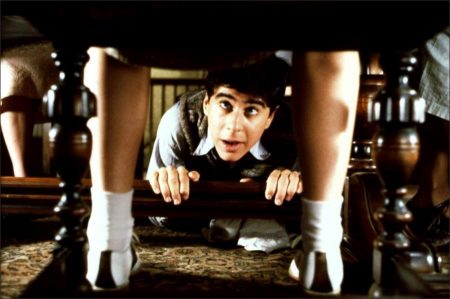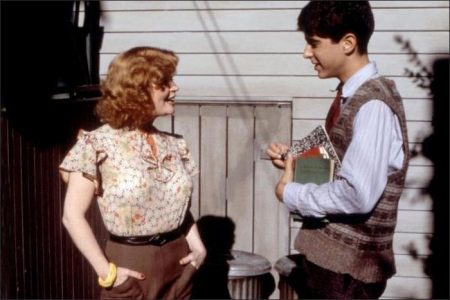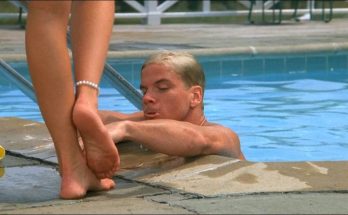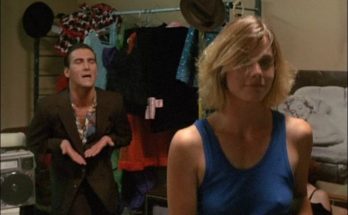Taglines: Meet Eugene Jerome and his family, fighting the hard times and sometimes each other.
Brighton Beach Memoirs movie storyline. Set in the Brighton Beach section of Brooklyn, New York in September 1937 amidst The Great Depression , this coming-of-age comedy focuses on Eugene Morris Jerome, a Polish-Jewish American teenager who experiences puberty, sexual awakening, and a search for identity as he tries to deal with his family, including his older brother Stanley, his parents Kate and Jack, Kate’s sister Blanche, and her two daughters, Nora and Laurie, who come to live there after their father’s death.
Brighton Beach Memoirs is a 1986 American comedy film directed by Gene Saks, written by Neil Simon, and starring Jonathan Silverman and Blythe Danner. Simon adapted his semi-autobiographical 1983 play of the same title, the first chapter in what is known as the Eugene trilogy, followed by Biloxi Blues and Broadway Bound. The film frequently breaks the fourth wall by having Eugene speak directly to the camera.
Film Review: Brighton Beach Memoirs
Neil Simon is hardly Norman Rockwell, but his ”Brighton Beach Memoirs” has a warmly nostalgic quality, something that has traveled very nicely to the screen. ”Brighton Beach Memoirs,” the first and perhaps the most sweetly rueful play of Mr. Simon’s autobiographical trilogy, has become a film of surprisingly gentle charms. Mr. Simon’s humor is much in evidence, but it is not the film’s strongest selling point. Even more effective are the sense of a place and a way of life long vanished and the care and affection with which they have been summoned up.
”Brighton Beach Memoirs,” which opens today at the Paramount and other theaters, is Mr. Simon’s first portrait of the young would-be writer Eugene Jerome, and of the family life whose very closeness is a touching anachronism. The play is set in 1937, in a house small enough to insure that no one ever, under any circumstances, is afforded one shred of privacy. There, Eugene (Jonathan Silverman) is experiencing the libidinous throes of adolescence. His changing behavior is closely observed by his hardworking, hard-worrying mother (Blythe Danner); by the older brother (Brian Drillinger), who’s forced to share a room with him (”If I was your sister, I wouldn’t sleep on the same block with you,” this brother declares.), and even by his discouraged, exhausted father (Bob Dishy), who holds down two jobs and movingly embodies the film’s Depression-era ethos.
To a lesser extent, Eugene’s preoccupation is even noticed by his Aunt Blanche (Judith Ivey), a widow who has moved, either temporarily or permanently, into the Jerome household with her two daughters. The younger of these (Stacey Glick) is a sickly bookworm, but the older (Lisa Waltz) is pretty enough to give the story Portnoyesque possibilities, in view of Eugene’s greatly heightened awareness of the opposite sex. But ”Brighton Beach Memoirs,” while allowing Eugene more than enough wishful thinking, remains determinedly innocent, not just about Eugene’s hot-bloodedness but also about the life that awaits him. It remains firmly anchored in the atmosphere of hard work, simple values and constant carping that Mr. Simon so fondly recalls.
Though it eventually develops some small modicum of suspense – Will Aunt Blanche have a romance with the man across the street? Will brother Stanley move out? – ”Brighton Beach Memoirs” is essentially a still life, and on film it’s a glowing one. As directed by Gene Saks and evocatively photographed by John Bailey, the film has a 1930’s look that manages to be both elaborate and casual. Period props are everywhere – the film makers reportedly repainted the houses on a Brooklyn block to get the right look and even replaced window frames and telephone poles – and yet they aren’t unduly conspicuous. The film’s look is simply inviting and believable, the perfect backdrop for the Jerome family and its incessant comic squabbling.
Eugene, as played perkily by Mr. Silverman, is a bit too much of a sitcom character, stopping the action with asides to the audience and generally seeming more one-dimensional than the rest of his family. But the older characters are moving in deeper ways: the mother for her loving fretfulness and for her constant flurry of activity (Miss Danner nervously sews, darns, cooks or peels something in virtually every scene), the widowed aunt for her grief and tentativeness, the father for his worried air. Miss Danner, Miss Ivey and Mr. Dishy are all exceptionally fine. The jokes are an added bonus (”The tension was so thick you could cut it with a knife, which is more than I could say for the liver,” Eugene says at dinner.), but they are never the heart of the matter.
”Brighton Beach Memoirs” also has a richly ethnic flavor, which comes from the writing rather than the casting and adds greatly to its authenticity. There is, for instance, the way Eugene’s Jewish mother complains loudly and unreasonably about her sister’s Irish suitor, who lives just across the street. ”Stay on your own side of the street, that’s what they have gutters for,” she counsels in typically tolerant fashion. Mr. Simon also has a rewardingly keen memory of the perfect illogic with which such a mother might exert her iron rule. When Eugene complains about being sent out for the second time in one day to buy a quarter-pound of butter, his mother says, ”And suppose the house burned down this afternoon? What would I do with an extra quarter-pound of butter?”
For anyone who finds a remark like that even vaguely recognizable, the film version of ”Brighton Beach Memoirs” is funny, affecting and, in the best sense, familiar.
Brighton Beach Memoirs (1986)
Directed by: Gene Saks
Starring: Blythe Danner, Jonathan Silverman, Stacey Glick, Lisa Waltz, Judith Ivey, Brian Drillinger, James Handy, Kathleen Doyle
Screenplay by: Neil Simon
Production Design by: Stuart Wurtzel
Cinematography by: John Bailey
Film Editing by: Carol Littleton
Costume Design by: Joseph G. Aulisi
Set Decoration by: George DeTitta Jr., Gary Jones
Art Direction by: Paul Eads
Music by: Michael Small
Distributed by: Universal Pictures
Release Date: December 25, 1986
Views: 192





